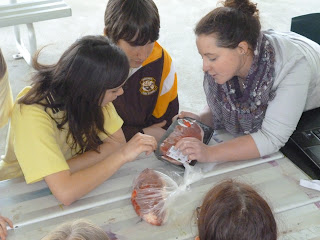So now for some calculations..............
Using the information provided in the Archibull Program Manual on page 24 we calculated the kilograms consumed per person per day for each of the commodity groups by dividing the Sydney totals by the population for Sydney which is 4 600 000 people. We then used the value per person and multiplied it by our local population of 98 076 people. We also calculated how much produce or animals that equated to.
We also realised that there were commodity groups such as fish and shellfish and synthetic fabrics that were also consumed by our community but we don't have any statistics for these groups so we might try and find out what we can.
There is also the question of how much food do we waste? As a country we waste around 4 million tonnes of food a year which is a terrible amount especially when 1.2 million Australians do not have access to a safe and nutritious food supply!
What it takes to feed and clothe the Shoalhaven community in one day
Commodity group
|
Kilograms consumed per day in Sydney
|
Kilograms per person per day
|
Kilograms for Shoalhaven population
|
Produce/animals required
|
Produce/animals required per person
|
Animals needed
Shoalhaven
|
Pork
|
303,726 kg
|
0.0474571875 kg
|
4654.4 Kg
|
10,847 pigs
|
0.00169484375
|
166.2 pigs
|
Horticulture
|
2,090,795 kg
|
0.3266867188 kg
|
32040.1 Kg
|
8,664,032 fruit & vegetables
|
1.353755
|
132770.8 fruit &veges
|
Poultry
|
1,295,562 kg
|
0.2024315625 kg
|
19853.7 Kg
|
1,423,832 hens
|
0.22247375
|
21819.3 hens
|
Meat and Livestock
|
577,205 kg
|
0.09018828125 kg
|
8845.3 Kg
|
9014 beasts
|
0.0014084375
| |
Dairy
|
1,817,315 kg
|
0.2839554688 kg
|
27849.2 Kg
|
390,146 dairy cows
|
0.0609603125
|
5978.7 dairy cows
|
Grains
|
693,151 kg
|
0.1083048438 kg
|
10622.1 kg
|
31543 loaves of bread
|
0.0049
|
483.4
loaves
|
Bees (honey)
|
12603kg
|
0.002739782kg
|
268.7
|
882,191,781 bees
|
137.8424658
|
13519037.7
bees |
Rice
|
163,836 kilograms
|
0.025599375 kg
|
2510.7
|
8,191,780,822 grains of rice
|
1279.965753
|
125533921.2 grains of rice
|
Cotton
|
1,854 bales = 420,858 kilograms
|
0.0657590625 kg
|
6449.4
|
30,000 hectares of land
|
0.0046875
| 459.7 ha |
And.........
we have come up with a clever way of representing that on our cow....
 |
| Each of the food groups and the amounts required for the Shoalhaven's daily consumption |
 |
| The team putting the numbers on |
Speaking of Sweetie Meaty Pie................... our last day of term was filled with lots of creativity as we began painting after weeks of planning. Check out the pictures and videos below........
Sweetie Meaty Pie comes to life as Shoalhaven High Archibull team creates artwork
 |
| We are representing the Shoalhaven region on one side of our cow - you can see the coastline and Shoalhaven River and the farming land of the Shoalhaven floodplain |
 |
| Sweetie has an arrow on her head and the word INNOVATION across her horns to represent how Agriculture is moving forwards |
 |
| constructing our farmer |


























